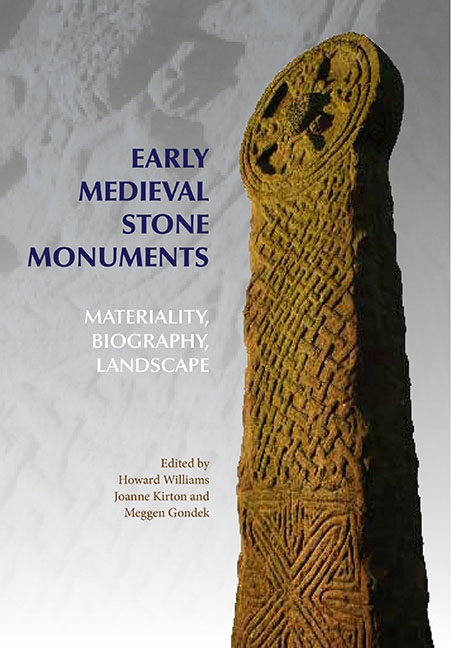Book contents
- Frontmatter
- Dedication
- Contents
- List of Illustrations
- List of Tables
- Acknowledgements
- 1 Introduction: Stones in Substance, Space and Time
- 2 Locating the Cleulow Cross: Materiality, Place and Landscape
- 3 Walking Down Memory Lane: Rune-Stones as Mnemonic Agents in the Landscapes of Late Viking-Age Scandinavia
- 4 Building Blocks: Structural Contexts and Carved Stones in Early Medieval Northern Britain
- 5 Memory, Belief and Identity: Remembering the Dead on Iniscealtra, Co. Clare
- 6 The Biographies and Audiences of Late Viking-Age and Medieval Stone Crosses and Cross-Decorated Stones in Western Norway
- 7 Lifeways in Stone: Memories and Matter-Reality in Early Medieval Sculpture from Scotland
- 8 A Stone in Time: Saving Lost Medieval Memories of Irish Stone Monuments
- 9 Hogbacks: the Materiality of Solid Spaces
- List of Contributors
- Index
5 - Memory, Belief and Identity: Remembering the Dead on Iniscealtra, Co. Clare
Published online by Cambridge University Press: 21 May 2021
- Frontmatter
- Dedication
- Contents
- List of Illustrations
- List of Tables
- Acknowledgements
- 1 Introduction: Stones in Substance, Space and Time
- 2 Locating the Cleulow Cross: Materiality, Place and Landscape
- 3 Walking Down Memory Lane: Rune-Stones as Mnemonic Agents in the Landscapes of Late Viking-Age Scandinavia
- 4 Building Blocks: Structural Contexts and Carved Stones in Early Medieval Northern Britain
- 5 Memory, Belief and Identity: Remembering the Dead on Iniscealtra, Co. Clare
- 6 The Biographies and Audiences of Late Viking-Age and Medieval Stone Crosses and Cross-Decorated Stones in Western Norway
- 7 Lifeways in Stone: Memories and Matter-Reality in Early Medieval Sculpture from Scotland
- 8 A Stone in Time: Saving Lost Medieval Memories of Irish Stone Monuments
- 9 Hogbacks: the Materiality of Solid Spaces
- List of Contributors
- Index
Summary
INTRODUCTION
The island of Iniscealtra is situated in Scarriff Bay on Lough Derg, on the lower River Shannon, near the boundaries between counties Clare, Galway and Tipperary (Fig. 5.1). Although the earliest phase of Iniscealtra's history remains somewhat obscure, hagiographical and annalistic evidence imply the presence of an ecclesiastical settlement there by the early to midsixth century (AFM 548; AU 549; VSH 229 §15; Ó Riain 2011, 210, 422). Moreover, excavation confirmed that habitation was continuous from the seventh century (de Paor 1997, 92; 2013, 43). Today this major ecclesiastical complex preserves the remains of five churches (usually surrounded by a cemetery), a round tower and various medieval and post-medieval monuments, including a shrine-structure, a holy well, bullaun stones and a network of earthworks (Fig. 5.2). Its sculptural collection includes over seventy cross-inscribed stones, approximately forty plain grave-slabs, several high crosses and smaller crosses, as well as numerous cross-bases and socketed stones. Sundials and architectural pieces also endure.
In the nineteenth and early twentieth centuries Iniscealtra's sculpture attracted antiquarian attention (Brash 1866; Petrie 1878, 41–4; Deane 1880; Westropp 1900–02, 124–6, 155–7; 1906; Macalister 1906; Crawford 1907, 203–4; 1912, 228–9). In 1916, R. A. S. Macalister made the first coherent attempt to catalogue the collection in its entirety by producing line drawings with accompanying descriptions. The sculpture was cited in several publications from the mid-twentieth century onwards (including Macalister 1949, nos 888–906; Lionard 1961, 148–9; de Paor 1977, 99; Henry 1970, 123–4; Higgitt 1986, 127–9, 147; Killanin and Duignan 1989, 250; Harbison 1991, 127; 1992, nos 118–21; Ó Floinn 1995, 258; Swift 1999, 111–13; Marshall and Rourke 2000, 105). Following his excavations on Iniscealtra in the 1970s, Liam de Paor (1997, appendices D–F) sought to produce an updated catalogue; owing to his untimely death, however, this was never completed. Despite the impressive scale of the collection, it has been largely ignored by modern scholarship. The only principal exception is the inclusion of twenty-two pieces in Elisabeth Okasha and Katherine Forsyth's (2001, 46–106) Munster corpus of inscriptions; this author has subsequently discovered a twenty-third inscribed stone on Iniscealtra. In seeking to remedy this neglect, I undertook a detailed survey and comprehensive analysis of the entire collection.
- Type
- Chapter
- Information
- Early Medieval Stone MonumentsMateriality, Biography, Landscape, pp. 114 - 148Publisher: Boydell & BrewerPrint publication year: 2015
- 2
- Cited by



